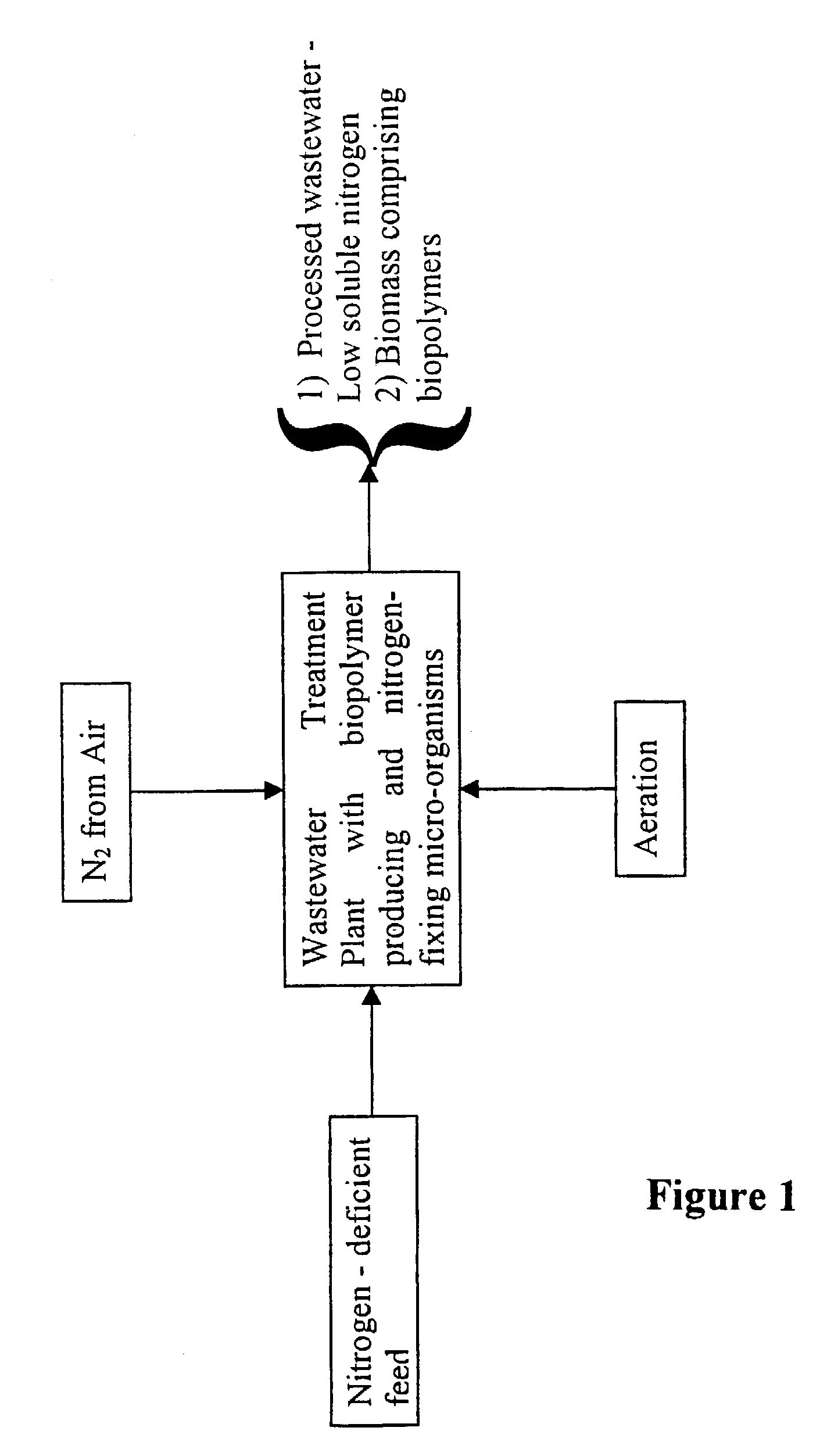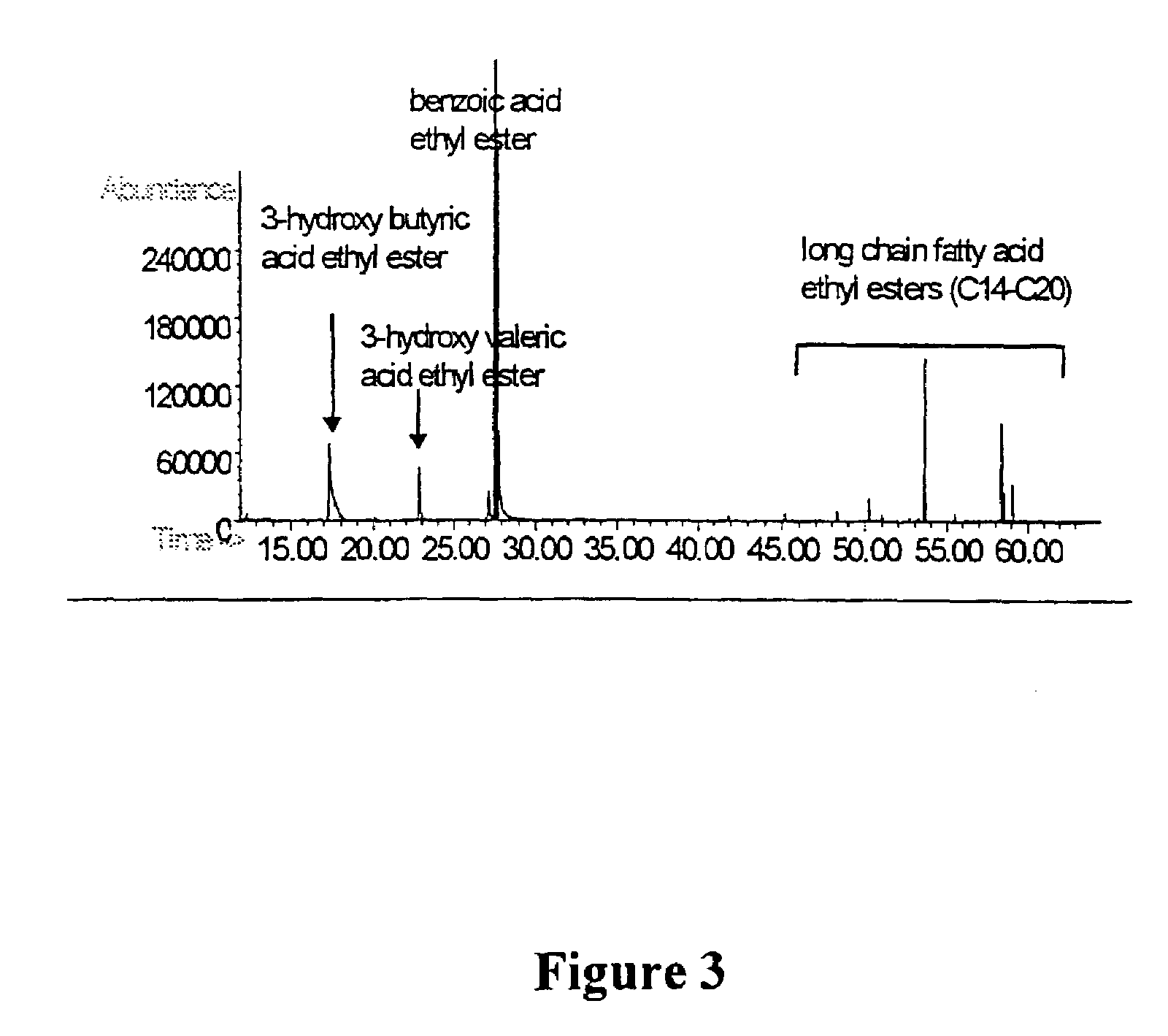Process for production of biopolymers from nitrogen deficient wastewater
a technology of biopolymer and wastewater, which is applied in the direction of biological water/sewage treatment, water/sludge/sewage treatment, byproduct vaporization, etc., can solve the problems of nitrogen deficiency, industrial wastewater is also nitrogen-deficient, and the nutrient nitrogen required in pulp and paper mill wastewater is typically low, so as to promote growth and/or activity, stable dissolved oxygen level
- Summary
- Abstract
- Description
- Claims
- Application Information
AI Technical Summary
Benefits of technology
Problems solved by technology
Method used
Image
Examples
example 1
[0028]Production of intracellular biopolymers and removal of soluble organic material (COD(s)) was studied in a continuous stirred tank reactor (CSTR) system without recycle under three different feed substrate concentrations. The CSTR was operated under nitrogen fixing conditions of controlled dissolved oxygen. The BOD:N ratio was approximately 100:0.3.
[0029]Table 1 gives a summary of the main parameters obtained in this work for the three different feed substrate concentrations.
[0030]
TABLE 1Biomass N and treatment performance data obtained from CSTRConditionConditionConditionParameter123Feed COD(s)mg / L450840630HRTd0.50.50.5Dissolved oxygen%303030Observed yieldmgTSS / mgCOD0.18–0.260.14–0.190.14–0.19COD(s) removedmg / L180–252590–630388–426%44–5372–7463–66Reactor biomassmg / L47–57107–12970–86N-fixation ratemgN / mgTSS.d0.09–0.160.13–0.150.12–0.15Biomass NmgN / mgTSS0.04–0.070.06–0.070.06–0.07Biomass PmgP / mgTSS.002–007.007–.0130.070.011
[0031]Table 1 presents data on the nitrogen content of t...
example 2
[0035]A nitrogen fixing bioreactor treating a pulp and paper wastewater with a BOD:N ratio of approximately 100:0.8 was operated under nitrogen-fixing conditions. Samples from the mixed liquor were characterised and quantified using a transesterification ethyl / propyl-ester derivatisation and GC-MS technique.
[0036]A range of PHA contents between 1.2% to 11% dry weight of biomass were measured in the microbial biomass.
[0037]FIG. 3 is a chromatogram showing the abundance of ethyl ester derivatives of an extract from the nitrogen fixing bioreactor. The PHA produced consisted of 3-hydroxybutyrate (3HB), 3-hydroxyvalerate (3HV) and 3-hydroxyhexanoate units. Benzoic acid was used as an internal standard. It has been observed that PHAs with different relative monomer compositions were produced under different bioreactor conditions.
example 3
[0038]The following results were obtained from a single stage activated sludge pilot plant. The feed to the pilot plant was thermomechanical pulping wastewater (TMP) with a BOD:N ratio of 100:0.8 and a loading rate of BOD51.07 kg BOD5.m−3.d−1. Nitrogen was not supplemented. Dissolved oxygen was controlled at 14% in phase one of the experiment and 5% during phase two of the experiment.
[0039]
TABLE 3PHA production from a nitrogen-fixing activatedsludge system treating pulp and paper wastewaterNom-Total PHAinalproduction*,3-OH-3-OH-valerateDODO level,g / kg drybutyrate,valerate,tosetting,% mean + / −weight% total% totalbutyrate%95% ClbiomassPHA*PHA*ratio1413.79 + / − 0.024183170.2013.75 + / − 0.013080200.2413.76 + / − 0.046883170.2013.54 + / − 0.062570300.43mean4179210.2795% Cl19660.1054.46 + / − 0.024447531.154.57 + / − 0.133948521.074.53 + / − 0.044070300.43mean4155450.8895% Cl315150.45*hydroxybutyrate and hydroxyvalerate only congeners analysed in this example
[0040]Biomass production rates: Pilot slud...
PUM
| Property | Measurement | Unit |
|---|---|---|
| dry weight concentration | aaaaa | aaaaa |
| composition | aaaaa | aaaaa |
| concentration | aaaaa | aaaaa |
Abstract
Description
Claims
Application Information
 Login to View More
Login to View More - R&D
- Intellectual Property
- Life Sciences
- Materials
- Tech Scout
- Unparalleled Data Quality
- Higher Quality Content
- 60% Fewer Hallucinations
Browse by: Latest US Patents, China's latest patents, Technical Efficacy Thesaurus, Application Domain, Technology Topic, Popular Technical Reports.
© 2025 PatSnap. All rights reserved.Legal|Privacy policy|Modern Slavery Act Transparency Statement|Sitemap|About US| Contact US: help@patsnap.com



